 Technology
Technology
elk is Teijin's own developed special material. Teijin brings the high quality spec of elk to you.
High performanced Polyester cushion material, elk®
elk is the cushioning material which has a big role in our various fields of life.
The key point is our elk high performanced Polyester cushion.
Excellent stability at an intersection of the fiber structure makes the basic performances improve, such as the air permeability, the elasticity and the durability.
And even if it burns, there is little toxic gas, therefore our elk makes a substantial contribution to the global environment, industry and life.
The key point is our own special elastomer.
-
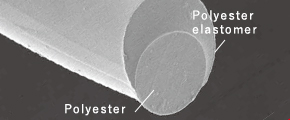
The sheath / core structure
Our own special elastomer makes the stable cross point keep the form of structure, and the basic structure which keeps the appropriate hardness upon loading.
-
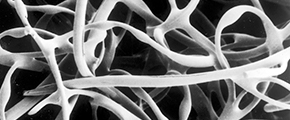
Flexible bonded section and structure
elk has a 3-dimentional non-woven structure, and it helps keep a stable fix at the cross point.
-
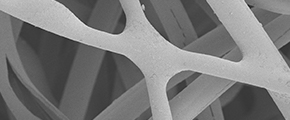
Fix firmly at the forme in the shape of an ameba
Comparing with regular fiber used non-woven, our material has more flexible and firm bonding point.
6 Features of elk®
 No yellowingSuperior to yellowing resistance.
No yellowingSuperior to yellowing resistance.
elk is capable of long-lasting usage as this material is hardly ever yellowing.
 BreathableThanks to a 3-dimentional structure of non-woven, the humidity can be spread quickly.
BreathableThanks to a 3-dimentional structure of non-woven, the humidity can be spread quickly.
The key point is elk has a 3-dimentional non-woven structure.
It is enough space for water and humidity passing through. Additionally, an appropriate hardness of this structure enables to have and keep the durability for the load. Therefore, elk is a most suitable material for cushion.
| elk® | conventional non-woven | polyurethane | Reference | |
|---|---|---|---|---|
| Density kg/m3 | 34 | 34 | 40 | JIS-K-6400-1 |
| Hardness N | 295 | 314 | 295 | JIS-K-6400-2(25% compression stress) |
| Air permeability cc/cm2・sec |
130 | 115 | 3 | JIS-L-1913 |

elk® / Microphotograph
Air and humidity tend to penetrate between the fiber because of a 3-dimensional structure.

polyurethane / Microphotograph
Polyurethane's structure tends to keep moisutre inside because there are almost no gaps for air and humidity to get out.
 Light weightContribute to weight saving of a product.
Light weightContribute to weight saving of a product.
elk has a 3-dimentional non-woven structure with durable, and it helps reduce the weight around 20~30% than polyurethane foam.
25% IFD (Initial Force deformation) ; aprx. 200N, thickness 30mm (weight comparison)
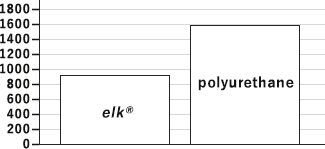
 ElasticityThe strong and flexible structure is endured by compression from all directions.
ElasticityThe strong and flexible structure is endured by compression from all directions.
elk has a 3-dimentional non-woven structure with a stable bonding point. Therefore, this bonding point is stronger and more flexible than conventional non-woven, then elk structure helps to make better durability.
| elk® | conventional non-woven | polyurethane | Reference | ||
|---|---|---|---|---|---|
| Density kg/m3 | 34 | 34 | 40 | JIS-K-6400-1 | |
| Hardness N | 295 | 314 | 295 | JIS-K-6400-2(25% compression stress) | |
| Elasticity | compression recovery (%) | 63 | 46 | 48 | Teijin's test method (recovery ratio on 75% compression stress) |
| compression stress | 4.0 | 3.4 | 2.5 | Teijin's test method (65% compression stress / 25% compression stress) | |
75% SS curve (JIS-K-6400-2)
On the initial compression, elk feels soft due to the structure.
Even after compression, elk has superior recovery and durability.
-
SS curve graph
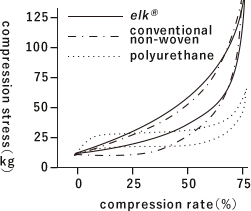
-
compression recovery graph
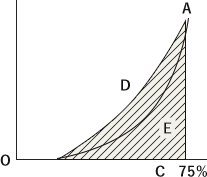
-
compression stress graph
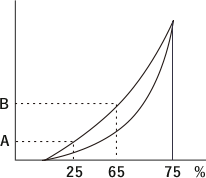
Compression recovery rate
The energy consumption ratio comparing between when compressed into 75%, and how much of it is needed to be recovered after 75% compressed. The higher value of compresion recovery ratio means better elasticity.

Compression stress comparison
Checking how much different of compression stress (push-back power) data when compressed into 25% and 65%.In case of small different value, this means we feel less cushioning.

 DurabilityStrong and flexible non-woven structures keep elasticity so long.
DurabilityStrong and flexible non-woven structures keep elasticity so long.
The tungle spring structure by ameba bonding point of elk is owing to the elastic polymer.This ameba bonding point keeps strong and more flexible to maintain the original performance.
| elk® | conventional non-woven | polyurethane | Reference | ||
|---|---|---|---|---|---|
| Density kg/m3 | 34 | 34 | 40 | JIS-K-6400-1 | |
| Hardness N | 295 | 314 | 295 | JIS-K-6400-2(25% compression stress) | |
| Durability | Hardness retention<A>% | 85 | 56 | 80 | JIS-K-6400-4 (50% compression x 80,000 cycles) |
| Hardness retention<B>% | 70 | 17 | 75 | Teijin's test method (800g/cm2 x 360 cycles compression) | |
| Hardness retention<C>% | 85 | 42 | 73 | Teijin's test method(previous JIS-S-1052、20㎏ Sand bag drop test) | |
Comparing durability test
(after 800g/cm2 x 360 times compression)
elk®

conventional non-woven

Even after many compression tests, still keep better resilience performance.
Hardness retention (B)
(By Teijin Ltd. test method ; load 0.8kg/cm2 x 15 sec.then take out all load in 10sec.Compressed cushion into 75% repeatedly in this cycle)
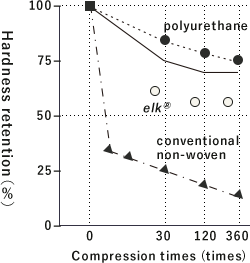
Hardness retention (C)
Teijin's test method(previous JIS-S-1052、20㎏ Sand bag drop test)
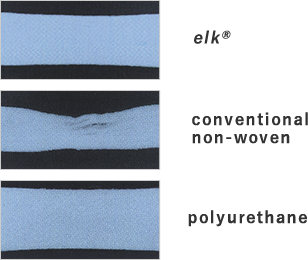
 SafetyEven under forced combustion situation, enables to reduce poisonous gas.
SafetyEven under forced combustion situation, enables to reduce poisonous gas.
elk is made of 100% polyester fiber.
Then, it can be reduced toxic gas on combustion.Additionally, it's a safety material.
Flame-resistance
Passed
(1) A-A(Alcohol) for train
(2) 45°Methenamine for bedding certification standard
(3) FMVSS 302 (Self-extinguishing) for automotive
| Test method | Test item | Estimated result |
|---|---|---|
| JIS K-2541 combustion tube method (400℃) |
hydrogen cyanide (HCN) (detection limit 0.005mg/g) | No detection |
| hydrogen sulfide (H2S) (detection limit 0.05mg/g) | No detection | |
| sulfur oxide (SOx) (detection limit 0.5mg/g) | No detection | |
| nitric oxide (NOx) (detection limit 0.5mg/g) | No detection | |
| hydrogen chloride(HCL) (detection limit 0.5mg/g) | No detection | |
| carbon monoxide (CO) | 34mg/g | |
| carbon dioxide (CO2) | 243mg/g |


 No Yellowing
No Yellowing Air permeability
Air permeability Light weight
Light weight Elasticity
Elasticity Durability
Durability Safety
Safety
